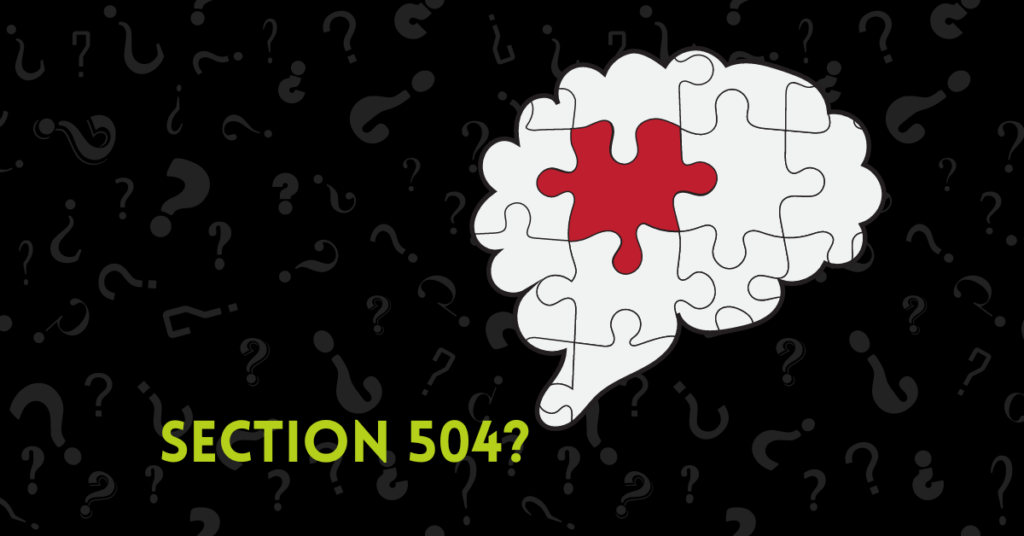Assessing a student’s eligibility under Section 504 of the Rehabilitation Act of 1973 and its 1974 Amendments involves navigating through a wealth of information. Unfortunately, this information is scattered across various sources, resembling a puzzle that parents, guardians, and educators need to piece together.
This post is designed to save you time by providing insights into common misconceptions about Section 504 and a student’s eligibility, eliminating the need to piece together the 504 puzzle.

Misconception #1
If a parent/guardian refuses to have his/her child evaluated, the school cannot evaluate the student.
Should the school perceive a student to have a disability, yet the parent/guardian withholds informed consent, the school has the option to initiate due process hearing procedures to pursue an override of the parental denial.
For details on the specific due process procedures in your area, consult your local district’s 504 coordinator.
Misconception #2
A 504 Plan is the same as an Individualized Education Plan (IEP).
A 504 Plan concentrates on implementing services and adjustments within the learning environment to align with the student’s requirements, ensuring the student’s parity with peers. Typically, it comprises a list of accommodations applicable within the regular education setting.
In contrast, an IEP comprehensively addresses all facets of a student’s education, delivering personalized special education tailored to the student’s needs. Unlike a 504 Plan, an IEP is not obligated to ensure that the student is on par with peers. It involves more extensive evaluation by a school psychologist and is generally a more comprehensive plan that may encompass accommodations or modifications beyond the regular education environment. If a student qualifies for an IEP, a 504 Plan is not needed.
For a deeper understanding, you can refer to A Day in Our Shoes’ article, “10 Differences Between IEP and 504 Plan (and what is the same!).“
Misconception #3
A student MUST have a 504 Plan to qualify for protections under Section 504.
The U.S. Department of Education does not mandate that a school create a Section 504 Plan. Nonetheless, many schools opt to document a student’s Free Appropriate Public Education (FAPE) under Section 504 in a written format. Typically, each school district establishes its own procedures for recording the 504 meeting and the determination of students’ eligibility. If a student requires services, a 504 plan is typically formulated.
A student identified with an impairment that restricts at least one major life activity may be eligible for safeguards under Section 504. If the evaluation team determines a student is eligible under Section 504, the team then assesses the need for a plan. Even if a plan is deemed unnecessary during the evaluation meeting, the student retains eligibility. If a plan is later deemed necessary, a meeting is convened to formulate the plan.
A student who is eligible under Section 504 receives nondiscrimination protections, procedural safeguards, manifestation determination, and periodic re-evaluation.
To learn about Section 504 eligibility, consult the post Section 504: What You Need to Know.
Misconception #4
A medical diagnosis is required to qualify under Section 504.
Even in the absence of a medical diagnosis, a 504 meeting can be convened if a student is thought have a disability. If there is a belief that a student has an impairment hindering learning or significantly impacting a major life activity, a parent/guardian or school official can request an evaluation. Numerous sources, such as achievement tests, class assessments, input from teachers, administrators, parents, and students, as well as consideration of physical conditions, social and cultural backgrounds, and behaviors, can be utilized to determine eligibility.
A student who is regarded as having a disability may qualify for protection under Section 504. This scenario occurs when others perceive the student as having a disability, even if the student does not have an impairment. The ADA provides three examples of such situations, which are outlined below.
- An individual with mild diabetes, effectively managed by medication, is prohibited from participating in specific sports due to her diabetes.
- A child born with a noticeable facial disfigurement is denied entry into a program, with the justification that her presence may disturb other children. The student faces limitations in major life activities solely because of others’ attitudes toward her physical impairment.
- A student is excluded from a county-sponsored soccer team based on unfounded rumors about being infected with the HIV virus. Despite the falseness of these rumors, the student is protected from discrimination by the county, which is rooted in the belief that he has an impairment significantly restricting major life activities.
Misconception #5
Having a medical diagnosis or impairment guarantees eligibility under Section 504.
While possessing a medical diagnosis serves as a solid foundation for requesting a 504 meeting, it is not mandatory. If there is documentation of a physical or mental impairment, providing a copy to the evaluation team can be advantageous. In the process of assessing a student for 504 eligibility, it’s essential to consider various sources. However, the evaluation team should give due consideration to the diagnosis and how it affects major life activities.
No particular impairments automatically grant a student eligibility for safeguards under Section 504. The evaluation team must individually assess each student’s specific impairment and its impact on major life skills. Evaluations are conducted on a case-by-case basis, utilizing a range of sources to determine eligibility.
Misconception #6
Good grades or good academic standing means a student isn’t eligible under Section 504.
Academic performance alone cannot be a basis for avoiding an evaluation for 504 eligibility. While not all impairments qualify for Section 504 protections, it’s essential to assess the impact of the student’s impairment. If the impairment substantially limits a major life activity, the student becomes eligible for protection, and the evaluation team must determine if additional services are necessary.
Misconception #7
An impairment that is episodic or in remission doesn’t qualify a student for protection under Section 504.
Like any impairment, an episodic or remittent condition necessitates evaluation to gauge its influence on major life activities. If the impairment significantly affects the student’s life during an active state, the student may be eligible under Section 504.
For a temporary impairment, an assessment is essential to determine its lasting impact on major life activities. Generally, both the duration of the impairment and its effects on the student’s major life activities are considered. An impairment is not considered a disability if it is transient, lasting 6 months or less.
Misconception #8
If a school denies a student eligibility, there is nothing more a parent/guardian can do.
Should a school decline to evaluate a student or deny eligibility under Section 504, it is mandatory for the school to furnish the parents/guardians with details about their right to challenge the decision.
In the event of disagreement, parents/guardians can formally request an impartial hearing, commonly referred to as a due process hearing. The school or district will outline the procedure for this hearing, during which parents/guardians have the option to be represented by legal counsel. If a parent opts to engage legal representation, it is advisable to notify the hearing coordinator. The district also reserves the right to have legal counsel present, and informing them in advance helps avoid the need for rescheduling the hearing.
Additionally, parents/guardians have the option to seek an evaluation from an outside specialist. Schools are obligated to take into account the findings of the external evaluation.
Misconception #9
Once a student has a 504 Plan, it’s forever.
While there isn’t a specific regulation stipulating the frequency of 504 re-evaluations, periodic re-evaluations are required. If, during a re-evaluation, the team concludes that a student’s impairment no longer significantly limits a major life activity, the student is considered ineligible. Consequently, in such instances, the student no longer retains protection under Section 504.
Misconception #10
A student eligible under Section 504 cannot be disciplined.
Students who have qualified under Section 504 are still required to adhere to the school’s Code of Conduct. However, there are limitations on the duration of exclusion for a student with a disability from their regular educational setting. According to the Office of Civil Rights (OCR), a removal of 10 consecutive days or a cumulative total of 10 days indicating a pattern of removal is considered a significant change in placement. This encompasses informal removals, such as a parent being required to pick up the child early due to misbehavior.
Before implementing any exclusion surpassing 10 days, a reevaluation must be conducted to determine if the misconduct is linked to or caused by the student’s disability. This process, known as a manifestation hearing, determines the course of disciplinary action.
Behavior is NOT a manifestation of the student’s disability
If the hearing establishes that the behavior is unrelated to the disability, the student may be disciplined similarly to a student without a disability. However, the disciplinary measures for a student with a disability must not exceed the severity imposed on students without disabilities if their behaviors are comparable.
Behavior is a manifestation of the student’s disability
If it is determined that the behavior is related to the disability, there are constraints on the permissible extent of discipline, typically outlined in the district’s Code of Conduct. It is essential to ensure that the imposed disciplinary measures do not infringe upon the student’s right to FAPE. For further guidance, “Supporting Students with Disabilities and Avoiding the Discriminatory Use of Student Discipline under Section 504 of the Rehabilitation Act of 1973” serves as a valuable resource.
In situations where the behavior is acknowledged as a manifestation, the evaluation team must also assess the suitability of the student’s existing placement. Additionally, the team needs to determine whether additional or alternative services are necessary and whether the student’s conduct impedes the ability for students to learn.
Behavior that is an immediate threat
If a student’s behavior poses an immediate or serious threat to the safety of others, the student may be promptly removed from the educational setting, regardless of their disability status. This incident becomes part of the evaluation process in a manifestation hearing, which must occur before the 11th day of removal.

Some of the resources have been linked within the post. However, while piecing together the information related to Section 504, other resources that may not be linked were used. These include Title 34 – Education, Part 104; the Individuals with Disabilities Education Act (IDEA); the Americans with Disabilities Act of 1990, as Amended; and the ADA Amendments Act of 2008.
Although the law is intricate, valuable resources from the Office of Civil Rights and the United States Department of Education are available to assist in interpreting the implications of the law for students. These resources are provided in the list below.
- Free Appropriate Public Education for Students With Disabilities: Requirements Under Section 504 of the Rehabilitation Act of 1973
- Protecting Students with Disabilities
- The Civil Rights of Students with Hidden Disabilities Under Section 504 of the Rehabilitation Act of 1973
- Parent and Educator Resource Guide to Section 504 in Public and Secondary Schools
- Disability Discrimination
- Supporting Students with Disabilities and Avoiding the Discriminatory Use of Student Discipline under Section 504 of the Rehabilitation Act of 1973 and the accompanying Fact Sheet







